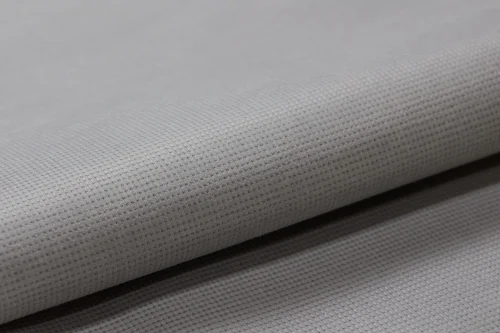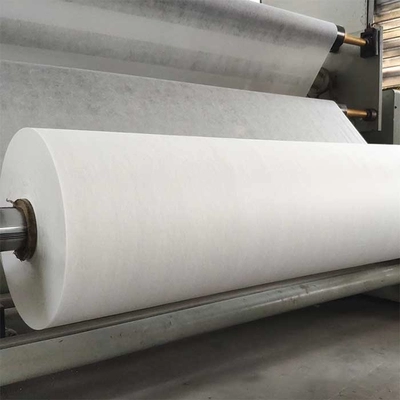Non woven interlining is critical in the textile industry, providing essential structure and support to various products. From apparel to home textiles, this material offers versatility and numerous benefits that enhance the functionality and aesthetics of finished goods. In the home textiles sector, Non woven interlining is used in various applications, each serving specific purposes to improve the quality and longevity of the products.
What is Non-woven interlining?
Non woven interlining is a fabric made from fibers bonded together through chemical, mechanical, heat, or solvent treatment. Unlike woven fabrics, Non woven interlining has no structured weave or knit. This unique construction gives Non woven interlining distinct properties that make it suitable for various applications.
Types of Non woven interlining
- Chemical Bonded: Fibers are bonded using adhesives or chemical binders.
- Thermally Bonded: Heat is used to bond the fibers together.
- Mechanically Bonded: Mechanical entanglement methods like needle punching bond the fibers.
- Spunbonded: Fibers are spun and then directly bonded by heat or chemicals.
Properties of Non woven interlining
- Lightweight: Non woven interlining is generally lightweight, adding minimal bulk to textiles.
- Breathable: Allows air and moisture to pass through, enhancing comfort.
- Flexible: Provides ease of use and adaptability to various shapes and sizes.
- Durable: Offers strength and resilience to withstand wear and tear.
- Cost-effective: Typically more affordable than woven or knitted interlining.
Applications in Home Textiles
1) Enhancing Durability
In upholstery, Non woven interlining adds durability and strength to furniture fabrics. It provides:
- A stable backing that prevents the upholstery fabric from stretching and sagging.
- Thus extending the life of sofas.
- Other furniture pieces.
2) Comfort and Padding
Non woven interlining also adds an extra layer of padding, contributing to the overall comfort of upholstered furniture. It helps distribute weight evenly, reducing pressure points and enhancing seating comfort.
Curtains and Draperies
Shape Retention
Non woven interlining is often used in curtains and draperies to help maintain their shape and structure. It provides the necessary stiffness that keeps the fabric from sagging, ensuring a neat and polished appearance.
Insulation and Light Control
By adding a layer of Non woven interlining to curtains, manufacturers can improve the draperies’ insulation properties. This helps regulate indoor temperatures and block out light, contributing to energy efficiency and enhanced privacy.
Bed Linens
Quilts and Comforters
In producing quilts and comforters, Non woven interlining is a middle layer that adds warmth and comfort. It helps evenly distribute the filling material, preventing it from clumping and ensuring consistent warmth throughout the bedding.
Mattress Pads
Non woven interlining is used in mattress pads to provide additional cushioning and protection. It also enhances the pad’s durability, allowing it to withstand repeated use and washing.
Table Linens
Stability and Aesthetics
For table linens such as tablecloths and placemats, Non woven interlining offers stability and enhances the drape of the fabric. It ensures that the table linens maintain a crisp and neat appearance, adding to the overall aesthetics of the dining area.
Wall Coverings
Texture and Stability
Non woven interlining is used in fabric wall coverings to provide texture and stability. It helps adhere the fabric to the wall smoothly, preventing wrinkles and ensuring a professional finish.
Acoustic and Thermal Insulation
Adding Non woven interlining to wall coverings can also improve their acoustic and thermal insulation properties. This helps reduce noise levels and maintain a comfortable indoor temperature.
Advantages of Using Non-woven interlining in Home Textiles
1) Cost-Effectiveness
Non woven interlining is generally more affordable than woven or knitted interlining, making it a cost-effective choice for manufacturers. This cost advantage allows the production of high-quality home textiles without significantly increasing the final product price.
2) Versatility
The flexibility and adaptability of Non woven interlining make it suitable for a wide range of home textile applications. Whether used in upholstery, curtains, or bed linens, Non woven interlining can be tailored to meet specific needs and requirements.
3) Enhanced Product Quality
Adding structure, stability, and durability, Non woven interlining enhances the overall quality of home textile products. It ensures that these products maintain shape, appearance, and functionality over time, increasing customer satisfaction.
4) Easy Handling and Processing
Non woven interlining is easy to handle and process, allowing for efficient production. Its lightweight and flexible nature simplifies cutting, sewing, and application, streamlining manufacturing.
Choosing the Right Non woven interlining
1) Consider the End Use
When selecting Non woven interlining for home textiles, it is essential to consider the product’s end use. Different applications may require specific properties, such as increased drapery stiffness or enhanced upholstery cushioning.
2) Evaluate Material Properties
The choice of non-woven interlining should be based on the desired material properties, including weight, thickness, breathability, and durability. Evaluating these properties ensures that the interlining meets the specific requirements of the home textile product.
3) Quality and Performance
Investing in high-quality, Non-woven interlining is crucial for achieving home textiles’ desired performance and longevity. Partnering with reputable suppliers and manufacturers can ensure consistent quality and reliability.
Innovations in Non woven interlining
1) Sustainable and Eco-Friendly Options
With the growing emphasis on sustainability, many manufacturers are developing eco-friendly, Non woven interlining options. These include interlining made from recycled fibers, biodegradable materials, and environmentally friendly production processes.
2) Advanced Bonding Technologies
Innovations in bonding technologies have led to the development of more robust and durable nonwoven interlining. Advanced techniques such as ultrasonic bonding and air-laid processes enhance the performance and versatility of nonwoven interlining.
3) Smart Textiles
The integration of intelligent textile technologies into Non woven interlining is an emerging trend. This includes interlining with embedded sensors or conductive fibers that offer additional functionalities such as temperature regulation, moisture management, and health monitoring.
Case Studies
Hotel Industry
1) Improving Guest Comfort
A leading hotel chain invested in high-quality Non woven interlining for their bedding and upholstery. The result was a noticeable improvement in guest comfort and satisfaction, leading to positive reviews and increased bookings. The Non woven interlining provided added durability and maintained the luxurious feel of the hotel interiors.
2) Enhancing Product Longevity
A home furnishing brand incorporated nonwoven interlining into its curtain and drapery products. The interlining helped maintain the shape and structure of the draperies, even after repeated washing and use. This added value to the products, resulting in higher customer loyalty and repeat purchases.
3) Versatile Crafting Material
Non woven interlining has become popular among DIY enthusiasts for various home decor projects. Its ease of use and versatility make it ideal for creating custom cushions, wall hangings, and other decorative items. The availability of Non woven interlining in different weights and finishes allows for creative and personalized home decor solutions.
Non woven interlining plays a pivotal role in the home textiles industry, offering numerous benefits that enhance finished products’ quality, durability, and aesthetics. From upholstery and curtains to bed and table linens, Non woven interlining provides essential support and structure. By understanding the various non-woven interlining types and their applications, manufacturers can make informed decisions to meet the specific needs of their home textile products. As innovations continue to emerge, the potential for Non woven interlining in home textiles will only expand, leading to more sustainable, high-performance, and versatile solutions.



Leave a Reply